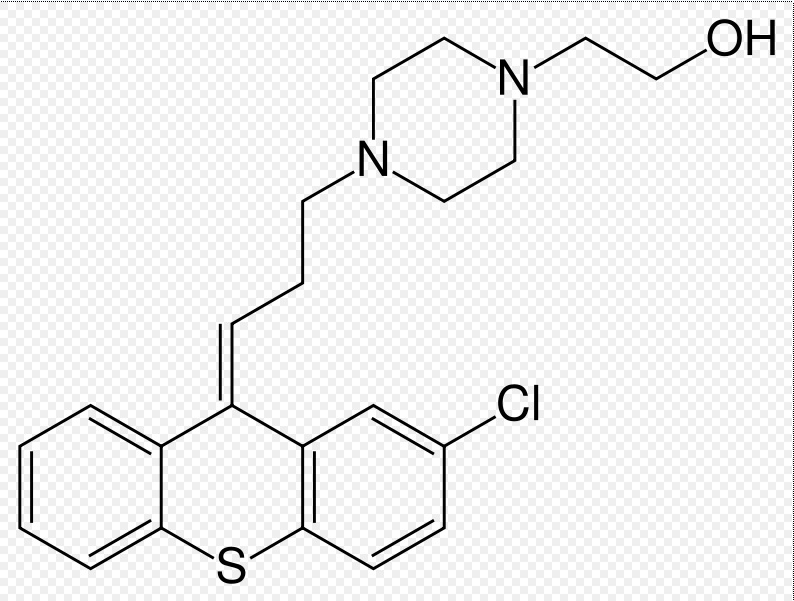Zuclopenthixol
 | |
 | |
| Clinical data | |
|---|---|
| Routes of administration | Intramuscular, oral |
| ATC code | |
| Legal status | |
| Legal status |
|
| Identifiers | |
| |
| CAS Number | |
| PubChem CID | |
| E number | {{#property:P628}} |
| ECHA InfoCard | {{#property:P2566}}Lua error in Module:EditAtWikidata at line 36: attempt to index field 'wikibase' (a nil value). |
| Chemical and physical data | |
| Formula | C22H25ClN2OS |
| Molar mass | 400.965 g/mol |
Editor-In-Chief: C. Michael Gibson, M.S., M.D. [1]
Zuclopenthixol (marketed as Cisordinol, Clopixol or Acuphase) is a typical antipsychotic neuroleptic drug of the thioxanthene group. It mainly acts by antagonism of D1 and D2 dopamine receptors, though it also has some antihistamine activity. It is produced and marketed by Lundbeck pharmaceutical company.
It is available in three forms:
- As zuclopenthixol decanoate (Clopixol), it is a long acting intramuscular injection. Its main use is as a long acting injection given two or three weekly to people with schizophrenia who have a poor compliance with medication and suffer frequent relapses of illness.[1] In some countries this can be involuntary under Community Treatment Orders. There is some evidence it may be more helpful in managing aggressive behaviour.[2]
- As zuclopenthixol acetate (Acuphase), it is a shorter acting intramuscular injection used in the acute sedation of psychotic inpatients. The effect peaks at 48–72 hours providing 2–3 days of sedation.[3]
- As zuclopenthixol dihydrochloride (Clopixol tablets), it is a tablet used in the treatment of schizophrenia in those who are compliant with oral medication.[4]
Side effects
The side effects are similar to many other typical antipsychotics, namely extrapyramidal symptoms as a result of dopamine blockade in subcortical areas of the brain. This may result in symptoms similar to those seen in Parkinsons Disease and include a restlessness and inability to sit still known as akathisia, a slow tremor and stiffness of the limbs.[4] Zuclopenthixol is thought to be more sedating than the related flupentixol, though possibly less likely to induce extrapyramidal syproms than other typical depots.[1] As with other dopamine antagonists, zuclopenthixol may sometimes elevate prolactin levels; this may occasionally result in amenorrhoea or galactorrhoea in severe cases. Neuroleptic malignant syndrome is a rare but potentially fatal side effect. Any unexpected deterioration in mental state with confusion and muscle stiffness should be seen by a physician.
Dosing
As a long acting injection, zuclopenthixol decanoate comes in a 200 mg ampoule. Doses can vary from 50 mg 3 weekly to (rarely) 400 mg 2 weekly. In general, the lowest effective dose to prevent relapse is preferred. The interval may be shorter as a patient starts on the medication before extending to 3 weekly intervals subsequently. The dose should be reviewed and reduced in side effects occur, though in the short term an anticholinergic medication benztropine may be helpful for tremor and stiffness, while diazepam may be helpful for akathisia. 100 mg of zuclopenthixol decanoate is roughly equivalent to 20 mg of flupentixol decanoate or 12.5 mg of fluphenazine decanoate.
In acutely psychotic and agitated inpatients, 50 - 200 mg of zuclopenthixol acetate may be given for a calming effect over the subsequent three days, with a maximum dose of 400 mg in total to be given. As it is a long-acting medication, care must be taken not to give an excessive dose.
In oral form zuclopenthixol is available in 10, 25 and 40 mg tablets, with a dose range of 20 - 60 mg daily.
References
- ↑ 1.0 1.1 da Silva Freire Coutinho E, Fenton M, Quraishi SN (1999). "Zuclopenthixol decanoate for schizophrenia". The Cochrane Database of Systematic Reviews. John Wiley and Sons, Ltd. doi:10.1002/14651858.CD001164. Retrieved 2007-06-12.
- ↑ Haessler F, Glaser T, Beneke M, Pap AF, Bodenschatz R, Reis O (2007), "Zuclopenthixol in adults with intellectual disabilities and aggressive behaviours", British Jounral of Psychiatry, 190: 447–448, doi:10.1192/bjp.bp.105.016535
- ↑ Lundbeck P/L (1991). "Clopixol Acuphase ® 50 mg/mL Injection Clopixol Acuphase ® 100 mg / 2 mL Injection". Lundbeck P/L. Retrieved 2007-06-12.
- ↑ 4.0 4.1 Kumar A, Strech D (2005). "Zuclopenthixol dihydrochloride for schizophrenia". The Cochrane Database of Systematic Reviews. John Wiley and Sons, Ltd. doi:10.1002/14651858.CD005474. Retrieved 2007-06-12.
- Pages with script errors
- CS1 maint: Multiple names: authors list
- Drugs with non-standard legal status
- E number from Wikidata
- ECHA InfoCard ID from Wikidata
- Chemical articles with unknown parameter in Infobox drug
- Articles without EBI source
- Chemical pages without ChemSpiderID
- Chemical pages without DrugBank identifier
- Articles without KEGG source
- Articles without InChI source
- Articles without UNII source
- Articles containing unverified chemical infoboxes
- Typical antipsychotics
- Drugs